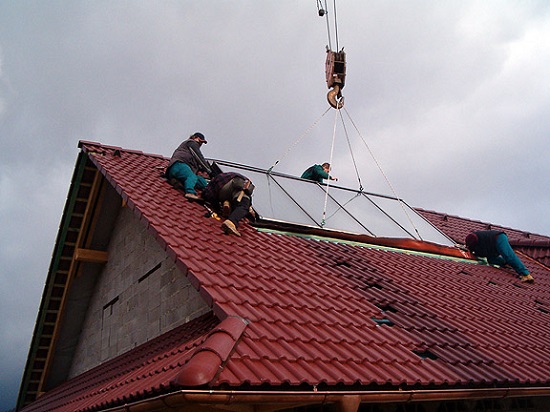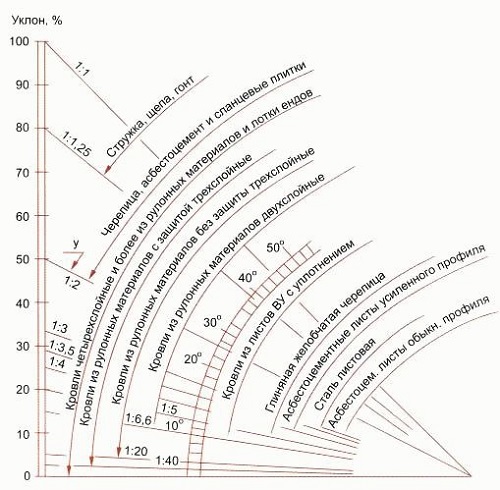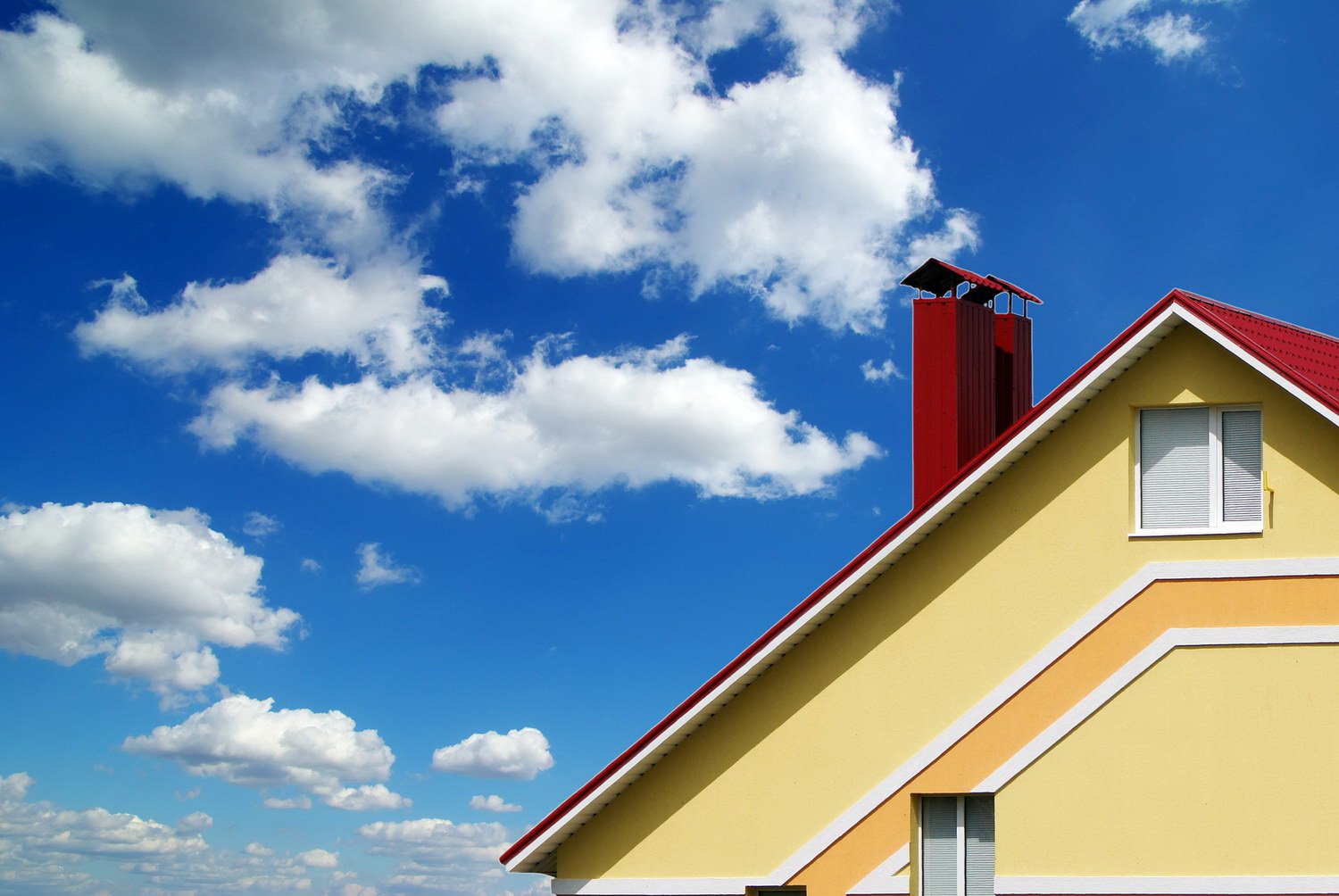
Roof construction is the last stage of building a house. But no less important than the erection of walls. After all, the roof protects our housing from the weather, and the aesthetic side of our home depends a lot on the type of roof.
It so happened, but flat roofs in our country can only be found in high-rise buildings. Cottages and private houses are crowned by pitched roofs. And builders consider the angle of inclination of the roof to be one of the main calculated indicators for building a house. Let's look at how to correctly calculate this indicator, what it depends on and how it affects the construction of the roof as a whole.
Content
Types of roofs and their dependence on the angle of inclination
Depending on the roof device, several types of roofs are distinguished:
- Shed roof. The roof is an inclined plane that lies on the walls of different heights. For such a roof, any material is suitable.
- Gable roof. This is a fairly reliable and easy to install roof. Consists of two slopes. Material for the roof can also be selected absolutely any.
- Tent overlap. The roof is a structure in which several isosceles triangles with their vertices close at one point. The rafter system at such a roof is quite complex, but consumables for it will require a minimum.
- Hip roof. It has four slopes (two triangular and two trapezoidal). The tops of the roof are cut off. By their design, roofs are very complex, but very economical in terms of material consumption.
- Vaulted overlap. Such roofs are made only of brick or stone. And as they are very heavy, today in individual construction almost never used
- Multi-gable roofs. Very complex, but beautiful configuration of many premixes and ribs.
So, the roof is considered pitched, if the angle of inclination of the roof exceeds 10 degrees.
There are exploited and non-exploitable roofs.
An unexploited roof is when there is almost no space between the roof itself and the upper ceiling, or this space is intended for technical purposes. Such roofs can be flat roofs with a slope of 2 to 7 degrees. In such roofs, the height of the space between the roof and the ceiling is not more than one and a half meters.
Building flat roofs is profitable. Minimum cost of materials, work. The wind will not rip off. Again, you can equip an additional place to relax. Recently, it has been very popular to lay a green roof on such roofs. But rainfall can spoil such a roof. Therefore, completely flat roofs are disadvantageous. Rainfall in puddles will accumulate on the roof surface and destroy it.

In order to create a natural outflow of water, a layer of ceramite is poured on flat roofs under a certain slope.
The pitched roofs allow you to use the space under the roof for household needs - an attic, an attic or even equip them with thorough insulation and living rooms.
Factors on which the roof angle depends most
The main factors affecting the roof pitch are:
- Natural factors. The angle of the roof depends on the climate of the area where the construction will take place. The wind exerts a huge load on the roof covering of the roof and on the rafter system as a whole. A slight increase in the slope angle (by about 30 degrees) increases the wind load by almost 5 times.But a slight angle can also play into the hands of the elements. So it will be easier for him to get into the roof through the joints of the coating and it is easy to tear off the roof. Precipitation can also have a devastating effect on roof performance. But with the help of a properly selected bias, you can avoid these troubles.

Remember that the maximum snow load on the roof is achieved by observing a roof slope of 30 degrees. And at 45 degrees, snow and rain do not linger on the roof at all.
-

Roof angle of metal Building codes define the minimum slope for each roofing material. They took into account the slope of the roof and snow loads, as well as wind performance. For example, for a roof made of tiles, the minimum recommended angle of the roof slope is 22 degrees, for slate - 30 degrees.
Thus, it is obvious that if you are going to build a house in a region where rainfall is very frequent, then a roof angle of 45 degrees is just right. But if there is not so much rainfall, but the wind blows year-round, then the best option is a roof with a slope of 30 degrees.
How to calculate the slope angle
How to determine the roof slope that will be optimal for your new home?

Remember that the greater the angle of the roof, the more costs you will incur for construction work.
The slope is calculated as the ratio of the size of the ridge to half the width of the building and all this multiplied by 100. Professional builders in case of calculating the roof slope indicators have their own instructions and calculations. Most of them use calculation matrices and special graphs. You can get acquainted with them on the World Wide Web.
The influence of the roof slope on the choice of roofing material (and not only)
An ideal roof that would suit all regions and roofing materials has not yet been invented.

So, the slope value was calculated. Now we select the roofing material. Slate and tile are suitable for a roof with an angle of more than 20 degrees. If the slope is smaller, then water will run into the joints, snow will clog, which means that the life of the roof itself will decrease.
Bitumen-based roll materials are used when covering flat roofs or the angle of the roof, which exceeds 30 degrees. With a high level of solar heating of such roofs and with a greater slope, the roof can simply slide down.
Metal profiles and metal tiles are used on roofs with a slope of at least 10 degrees.
Here is a list of the most common roofing materials:
- Roof tiles. Today is almost wildly popular. There are a large number of varieties of this material. Such roofs are easily repairable. But here you have to give a lot of finance for this material. But this material is very durable. Its service life can be calculated not only for decades, but also for centuries.
- Roofing panels. Such panels are made directly at the factories and in the final form represent an almost finished roof. Panels immediately contain several layers - both thermal insulation and vapor barrier and the stove itself. Installing such plates is very simple. No special equipment needed. The panels are attached to each other with a special tape. But such material is also very expensive.
- Metal profile. Galvanized steel sheets. Lightweight and durable enough material. Resists rust and is environmentally friendly. Today you can choose any color and size and direction of the waves. Manufacturers give a guarantee for this material for a period of 75 years.
- Piece materials from wood, such as shingles, shavings and shingles. As a rule, nobody uses such materials in modern construction. This material is not durable, can rot, microorganisms multiply on nm and easily ignite.
- Slate.This material for a long time remains reliable in operation, easy to install and inexpensive to purchase. Moisture-resistant, frost-resistant, fireproof. Yes, and today manufacturers have improved the appearance. You can choose a slate of any desired color.

When choosing a roofing material, remember, the denser its structure, the less the roof slope should be.
When using sheets of metal profiles and metal tiles on flat roofs, it is recommended to pass joints with moisture-proof and frost-resistant sealant. And also the size of the overlap of the sheets when installing the roof of these materials also depends on the angle of the roof. The steeper the roof, the less overlap. This also applies to slate.
When installing the roof, do not forget about the ventilation of the space under it. Pitched roofs also need to be equipped with a drainage system.
Thus, we can conclude that the angle of the roof is a very important indicator. Not only the quality of work, but also the life of the roof itself depends on it. The main thing is to correctly calculate the value, choose the desired roof structure, high-quality roofing material and a good team of workers. Well, and, of course, not all of this will require some voluminous budget. Good luck in the construction!





Alas, no comments yet. Be the first!